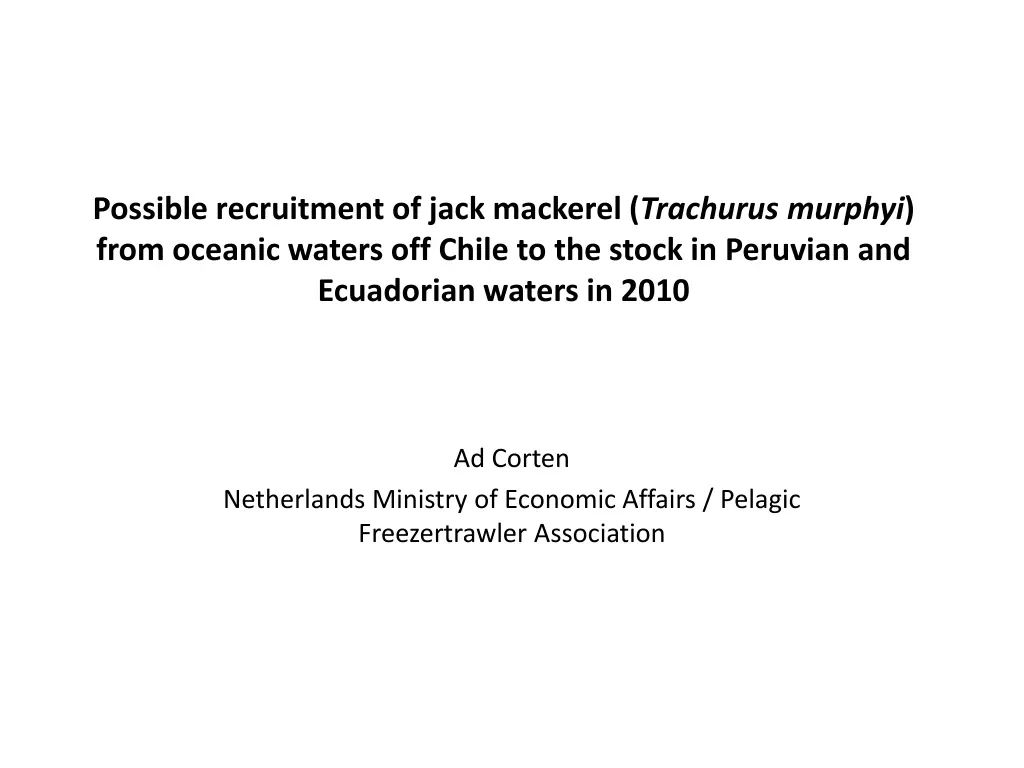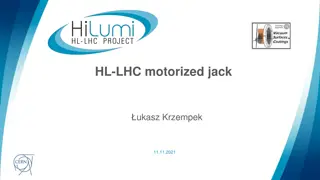
Insights into Jack Mackerel Recruitment and Catches
Discover the possible recruitment of Jack Mackerel from Chilean waters to Peruvian and Ecuadorian stocks in 2010. Explore the distribution of catches by fleet, length distributions, country-specific catch data, and pathways of juvenile mackerel during key periods. Gain valuable insights from detailed imagery and data analysis.
Download Presentation

Please find below an Image/Link to download the presentation.
The content on the website is provided AS IS for your information and personal use only. It may not be sold, licensed, or shared on other websites without obtaining consent from the author. If you encounter any issues during the download, it is possible that the publisher has removed the file from their server.
You are allowed to download the files provided on this website for personal or commercial use, subject to the condition that they are used lawfully. All files are the property of their respective owners.
The content on the website is provided AS IS for your information and personal use only. It may not be sold, licensed, or shared on other websites without obtaining consent from the author.
E N D
Presentation Transcript
Possible recruitment of jack mackerel (Trachurus murphyi) from oceanic waters off Chile to the stock in Peruvian and Ecuadorian waters in 2010 Ad Corten Netherlands Ministry of Economic Affairs / Pelagic Freezertrawler Association
120W 110 W 100 W 090 W 080 W 40 S 40 S 120 W 110 W 100 W 090 W 080 W Distribution of catches of juvenile jack mackerel < 25 cm (yellow squares) by the PFA fleet during the 2010 fishing season compared to catches of larger jack mackerel (red squares)
20 15 10 2007 5 0 15 17 19 21 23 25 27 29 31 33 35 37 39 41 43 45 47 49 51 53 55 20 Length distribution of PFA catches from 2007 2013 15 10 2008 5 0 15 17 19 21 23 25 27 29 31 33 35 37 39 41 43 45 47 49 51 53 55 20 15 10 2009 5 0 15 17 19 21 23 25 27 29 31 33 35 37 39 41 43 45 47 49 51 53 55 20 15 10 2010 5 0 15 17 19 21 23 25 27 29 31 33 35 37 39 41 43 45 47 49 51 53 55 20 15 10 2011 5 0 15 17 19 21 23 25 27 29 31 33 35 37 39 41 43 45 47 49 51 53 55 20 15 no observations 10 2012 5 0 15 17 19 21 23 25 27 29 31 33 35 37 39 41 43 45 47 49 51 53 55 20 15 10 2013 5 0 15 17 19 21 23 25 27 29 31 33 35 37 39 41 43 45 47 49 51 53 55
800 Peru Ecuador 600 thousand tonnes 400 200 0 2000 2001 2002 2003 2004 2005 2006 2007 2008 2009 2010 2011 2012 2013 1800 1600 Chile EU 1400 thousand tonnes 1200 1000 800 600 400 200 0 2000 2001 2002 2003 2004 2005 2006 2007 2008 2009 2010 2011 2012 2013 Catches of jack mackerel by country
110 100 90 80 60 70 Presumed pathway of juvenile jack mackerel from June to December 2010 0 Ecuador 10 Peru 20 Chile 30 Humboldt Current 40 South Pacific Current 50
Aug 2010 length distribution of commercial catches in Peru in November 2010 April 2012 Nov 2010 Dec 2010 Jan 2011 Feb Mar Apr May Jun Jul Aug Sep Oct Dec Jan 2012 Feb Mar Apr 10 15 20 25 30 35 40 45 50 Total Length (cm)
40 35 30 25 20 15 10 5 0 15 17 19 21 23 25 27 29 31 33 35 37 39 41 43 45 47 49 51 53 55 length distribution of jack mackerel catches in Ecuador in February 2011
40 35 30 25 total length 20 catches Peruvian fleet 15 EU catches in central Pacific 10 5 0 apr-11 apr-12 may-11 sep-10 dec-10 feb-11 sep-11 feb-12 jul-10 oct-10 mar-11 jul-11 oct-11 dec-11 mar-12 aug-10 aug-11 may -10 jan-11 jan-12 jun-10 jun-11 nov-10 nov-11 Time axis with modal length of juvenile jack mackerel in central Pacific (June 2010) and modal length in Peruvian catches (November 2010 April 2012). All measurements in total length
110 100 90 80 60 70 Presumed pathway of juvenile jack mackerel from June to December 2010 0 Ecuador 10 Peru 20 Chile 30 Humboldt Current 40 South Pacific Current 50
Positive SST anomalies in eastern Pacific in April 2010 illustrate the existence of an El Ni o in the first half of 2010
Strong negative SST anomalies in the eastern Pacific in September 2010 illustrate the existence of a La Ni a in the second half of the year
Suitable habitats for jack mackerel in the south-eastern Pacific
Classical scheme of juvenile jack mackerel migrations off Chile. From Arcos et al. 2001
ZE Flota Peruana Recent model for migrations of juvenile jack mackerel in the south-eastern Pacific. From Gretchina et al. 2007 ZC 15 C 15 C ZE Flota Chilena
Distribution of juveniles (red cloud) off Chile in a normal year (left) and in an El Ni o year (right). From Gretchina et al. 2007.
Chilean juveniles may be adopted by the Peruvian population Adopted Migrant hypothesis (McQuinn 1997) Pelagic fish develop an attachment to the area where they happen to be at the time they turn into adults In this way, juveniles from Chilean origin may turn into Peruvian jack mackerel with biological characteristics similar to the Peruvian population
Conclusions Immigration of juveniles from Chile into Peru are likely to happen during La Ni a periods A strong La Ni a occurred in the second half of 2010 This may have resulted in a transport of juveniles of year- class 2008 from Chile to Peru at this time The Chilean juveniles may have been adopted by the Peruvian population The occasional immigration of juveniles from Chile into Peru would explain the lack of genetic difference between the population in both areas






















